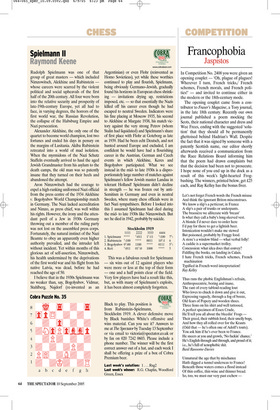Spielmann II Raymond Keene
Rudolph Spielmann was one of that group of great masters — which included Nimzowitsch, Alekhine and Rubinstein whose careers were scarred by the violent political and social upheavals of the first half of the 20th century. All four were born into the relative security and prosperity of late-19th-century Europe, yet all had to face, in varying degrees, the horrors of the first world war, the Russian Revolution, the collapse of the Habsburg Empire and Nazi persecution.
Alexander Alekhine, the only one of the quartet to become world champion, lost two fortunes and ended his days in penury on the margins of Lusitania. Akiba Rubinstein retreated into a world of mad isolation. When the myrmidons of the Nazi Schutz Staffeln eventually arrived to haul the aged Jewish Grandmaster from his asylum to the death camps, the old man was so patently insane that they turned on their heels and abandoned the attempt.
Aron Nimzowitsch had the courage to expel a high-ranking uniformed Nazi official from the press centre of the 1934 Alekhine v. Bogolyubov World Championship match in Germany. The Nazi lacked accreditation and Nimzo, as press chief, was well within his rights. However, the irony and the attendant peril of a Jew in 1930s Germany throwing out a member of the ruling party was not lost on the assembled press corps. Fortunately, the natural instinct of the Nazi Beamte to obey an apparently even higher authority prevailed, and the intruder left without incident. Yet within months of this glorious act of self-assertion, Nimzowitsch, his health undermined by the deprivations of the first world war and his flight from his native Latvia, was dead, before he had reached the age of 50.
I believe that in the 1930s Spielmann was no weaker than, say, Bogolyubov, Vidmar, Stahlberg, Najdorf (re-invented as an Argentinian) or even Flohr (reinvented as Homo Sovieticus), yet while these worthies continued to play and flourish, Spielmann, being obviously Germano–Jewish, gradually found his horizons in European chess shrinking — invitations drying up, restrictions imposed, etc. — so that essentially the Nazis killed off his career even though he had escaped to neutral Sweden. Indicators were his fine placing at Moscow 1935, his second to Alekhine at Margate 1938, his match victory against the very strong Petrov (whom Stalin had liquidated) and Spielmann’s share of first place with Flohr at Goteborg as late as 1939. Had he been echt Deutsch, and not hunted around Europe and excluded, I am confident he would have had a flourishing career in the Austrian, German and Czech events in which Alekhine, Keres and Bogolyubov participated. What we see instead in the midto late 1930s is a disproportionately large number of matches against Spielmann’s fellow Jewish master Landau in tolerant Holland! Spielmann didn’t decline in strength — he was frozen out by antiSemitism in Germany and even in neutral Sweden, where many chess officials were in fact Nazi sympathisers. Before I looked into this I assumed Spielmann had died during the midto late 1930s like Nimzowitsch. But no: he died in 1942, probably by suicide.
This was a fabulous result for Spielmann — six wins out of 12 against players who were more or less at the top of their form — one and a half points clear of the field. Very few players have had a result like this, but, as with many of Spielmann’s exploits, it has been almost completely forgotten.
























































 Previous page
Previous page